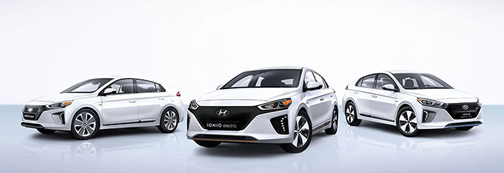|

New Hyundai hybrid an interesting and rewarding driveBy Jim Bray Hyundai's Ioniq green car is so new we don't even have a published price for it in Canada yet, but it's worth waiting for because the hybrid is so good to drive I kept forgetting it's an earth saver. Heck, I liked driving the Ioniq so much that, after all my hybrid humour and hammering over the years, I figure I'm risking a lightning bolt from above just for saying I like this car. And isn't that ioniq, er I mean ironic? Click on the image to open a slideshow. The Ioniq may also be quite iconic in the world of hybrids, in that - according to Hyundai - it offers three variations on its theme: hybrid, plug-in hybrid, and all-electric and, again according to the company, it's the only hybrid on earth that offers a dual clutch automatic transmission, in this instance a slickly-shifting six speed. This is especially interesting in a market niche dominated by continuously variable transmissions (CVT) that may help increase gas mileage but usually decrease the driver's involvement significantly. Hyundai Canada's sample was of the straight hybrid variety, which means it (and the plug-in version) comes with a new Kappa 1.6 litre four-cylinder, direct injection engine. The electric motivation to which its output is attached like a conjoined twin gets uses a lithium-ion polymer battery the company says allows for pure electric driving for up to 40 kilometres (in the Plug-in Hybrid version). The company rates the gas engine at a fairly minimal (for 2017) 104 horses, which rises to 139 when you take the electric motivation into account. Torque is a very nice 195 lb.-ft. Hyundai claims a potential 4.1 l/100 km (combined) fuel mileage. I kept the Ioniq in Sport mode once I discovered there was one (which was about 10 seconds after sliding my butt into the driver's seat), heavy on the gas and light on the "Green", and still managed to get 5.5 l/100 km. over my week with the car. I'd call that nothing short of remarkable. It was less than I got from the last Prius I drove (high 4's), but it drives better and its looks aren't as off-putting. Hyundai also claims up to 200 kilometres range for the all-electric model which, if true (and I have no reason to think it isn't), is a pretty usable spec as long as you take into account recharging time, weather, hills, etc.. Sport mode keeps the Ioniq in lower gears longer and combines the power from both power plants for maximized performance. In ECO mode (the default), the gear selection is optimized for fuel economy, which means it shifts to higher gears so fast you may wonder where the power went. It still drives pretty well that way, but the car really comes alive in Sport mode. The Ioniq is nothing if not nimble, too. The suspension feels great, nice and tight but not jarring; Hyundai says it includes MacPherson struts up front and a multi-link rear suspension with dual lower arms. Hyundai used aluminium at both ends to reduce the car's "gravity footprint" by 10 kilos relative to comparable steel components. The car stops fine, but what's with the brake pedal feel? I'm used to hybrid brakes that feel "funny" compared with non-hybrids because they're also regaining energy to recharge the battery pack, but in the Ioniq the pedal was very mushy and I really had to tromp on it for the stopping power to come on. Once it did it was fine, but it was a very weird feeling. You'd probably get used to it quickly if you owned the vehicle and, fortunately, that's the pedal I use the least anyway… Inside the Ioniq is a comfortable and attractive cabin that offers the typical connectivity drivers today look for - which means that, besides Bluetooth, the car is compatible with Apple CarPlay and Android Auto. It's also equipped with an LCD instrument cluster, an increasingly common feature today and one that allows for more flexibility in what it shows. In SPORT mode, for example, the display changes to show you a digital speedometer surrounded by an analogue-style tachometer, which is just how I like it. I also loved the fact that Hyundai has eschewed a cursor control-like device for accessing the stuff on the centre stack's LCD. Instead, they've combined the touch screen LCD with real - and large enough to be usable with gloves on - buttons. Alas, the LCD is a tad far away for my stubby little tentacles, though not so far away that it would be a deal breaker. There were no paddle shifters on Hyundai's sample, which was a darn shame, but you can shift manually via the shift lever. Hyundai's sample wore the "Limited" trim, the second highest trim level, and it's equipped about as well as one could want. Upgrades include leather, wireless phone charging, Adaptive Cruise Control, Lane Departure Warning System, Autonomous Emergency Braking with pedestrian detection, 17 inch "eco alloy wheels" with P225/45R17 Michelin LRR (low rolling resistance) tires, rear parking sensors, front passenger auto up/down window, electrochromic auto-dimming rear-view mirror with HomeLink transceiver and compass, chrome and aluminum enhancements inside and out, and more. Go up to the "Limited Plus" level and you'll be paying to add stuff like: adaptive HID headlights, High Beam Assist, an eight inch touch-screen navigation system, eight speaker Infinity premium audio system, driver's seat memory, a "Supervision" instrument cluster with a seven inch TFT LCD display, aluminum pedals and rear console air vents The Ioniq is a four door hatchback, but the rear window is split into two sections, one that's nearly horizontal and a smaller, nearly vertical part separated from the rest by a cross member that blocks your view rearward a tad. That isn't too bad, but when I was driving the Ioniq during early spring weather that caused our roads to be wet and disgusting, the vertical section would get very dirty very quickly and there was no rear wiper to clean it off. To be fair, I can't think of another vehicle with a rear window like this that has a wiper either; I just don't like it. I reached out to Hyundai Canada to find if they've announced pricing for the Ioniq, which they say will be available later this year, and it had yet to be written in stone. It's estimated, however, that the hybrid will be priced in the $24-$33,000 CAD range, with the electric version ranging from $35-$42,000. That, especially the hybrid price, seems quite reasonable considering what else is out there. The Toyota Prius, for example, starts at $27,190 CAD according to Toyota Canada's website and the Touring version starts at $30,425. Both Prius prices are without extra options added. Hyundai makes other cars and SUV's that I'd rather own than the Ioniq, but I must doff my derby to them for creating a hybrid that's not only economical (and, I assume, at least as friendly to Gaia as its competitors) but is also a relative hoot to drive. That's exactly the way it should be, but all too often isn't. If you're looking for a hybrid, perhaps you should hold off until the Ioniq is actually on the market. It's definitely worth your time to check it out, if you can wait that long. Copyright 2017 Jim Bray Jim Bray is a member of the Automobile Journalists Association of Canada. His columns are available through the TechnoFile Syndicate.
We welcome your comments! |
|
|||||||
